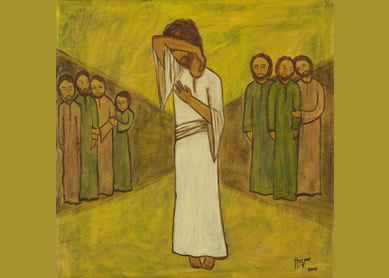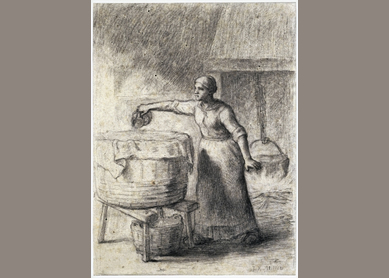Mary and Martha are not frequently mentioned in the New Testament, but their names are well known. The most famous story about them appears in Luke 10:38-42, but they also figure prominently in John 11:1-12:8 and in many postbiblical traditions. Although contemporary understandings of their significance to the early church have been eclipsed by the scholarly preoccupation with Mary Magdalene, they were highly revered by ancient Christians, and their role in the Gospels and beyond is starting to be recognized.
Who are Mary and Martha in the Bible?
Luke 10:38-42 portrays Jesus visiting the house of Martha (compare John 12:1, which has the meeting take place at the house of Lazarus, who is not mentioned in Luke’s story). Her sister, Mary, sits at Jesus’ feet listening to him. Martha, “distracted by her many tasks,” asks Jesus to tell Mary to help her. Jesus replies: “Martha, Martha, you are worried and distracted by many things; there is need of only one thing. Mary has chosen the better part, which will not be taken away from her” (Luke 10:41-42).
When most people read this story, they often imagine a harried housewife complaining about her lazy sister. Jesus’ gentle rebuke reminds his audience to attend to what’s important—his presence. However, Martha is not shown doing housework, and Jesus doesn’t specify what the “one thing…the better part” is. Rather, Martha is a householder who hosts Jesus; she is engaged in much “work” or, better, “service” (Greek: diakonian). By contrast, Luke depicts Mary as a disciple sitting at Jesus’ feet. Both women are engaged in different aspects of ministry, or ways of following Jesus and his teachings. The story illustrates how householders should treat visiting teachers. Mary Stromer Hanson observes that it isn’t even clear that Mary is in the house with Martha and Jesus; possibly, Martha’s complaint is that Mary’s discipleship has taken her away from home.
John 11:1-12:8 also features the sisters. Here, they are located in Bethany, and the story revolves around Jesus’ raising of their brother, Lazarus, from the dead. We are told that Jesus loved all three siblings (John 11:5), the only people mentioned by name in the Gospel as being loved by Jesus. Both women figure significantly in the story: Martha confesses that Jesus is the Messiah (John 11:27), and Mary’s tears prompt Jesus to raise Lazarus (John 11:28-44). In gratitude, Mary anoints Jesus’ feet with perfume at a banquet where “Martha served” (John 12:2). Here, Judas criticizes her for wasting money, but Jesus commends her. All four Gospels contain stories of a woman who anoints Jesus; only John names her as Mary of Bethany.
Who are Mary and Martha in Christian Tradition?
The sisters appear in many postbiblical traditions. Early Christians often interpreted Luke 10:38-42 as depicting active (Martha) and contemplative (Mary) vocations. Some later texts and artifacts depict the sisters at the cross and resurrection. The first usage of the title “apostle to the apostles” (third century) refers to Martha and Mary, not to Mary Magdalene. This tradition endures in the Orthodox icon of the holy myrrh-bearing women, including Mary, Martha, and Mary Magdalene.
The gospels name only one Martha, but multiple Marys: Mary of Nazareth (Jesus’ mother), Mary of Bethany (Martha’s sister), and Mary Magdalene. Because of their similar names, early Christians sometimes confused Mary Magdalene and Mary of Bethany. Contemporary scholars have perpetuated the confusion by identifying the Mary mentioned in some ancient texts (such as the Gospel of Mary and the Gospel of Thomas) as Mary Magdalene. However, in these texts, Mary is often not called “Magdalene”; she appears with Martha, she poses at Jesus’ feet; she is criticized by a disciple; she is defended by Jesus or a disciple; and she is a beloved disciple, commended by Jesus. That is, the woman called simply “Mary” is portrayed more like Mary of Bethany than Mary Magdalene. These texts portray Mary in many roles, from the woman who receives special revelations to miracle-working missionary and Eucharistic minister (see Beavis 2013).
Because the gospels mention so many women named Mary—and it’s hard to know which one is which—later Christians tended to conflate or compress them all into a single figure. Eastern Christians resisted this conflation, traditionally regarding the two Marys as distinct saints. In the West, however, Pope Gregory the Great pronounced, in the sixth century, that the “sinner” Mary who anointed Jesus’ feet (Luke 7:36-50) was Mary Magdalene rather than Mary of Bethany. A popular medieval French legend spread this idea, portraying Martha, Mary Magdalene, and Lazarus as missionaries to southern France, where Mary preached and performed miracles and Martha saved the village of Tarascon from a dragon, taming it with a cross and holy water. Many Christians—especially in France—continue to believe that Mary and Martha are buried in France, far from their native Bethany.
Bibliography
- Beavis, Mary Ann. “Mary of Bethany and the Hermeneutics of Remembrance.” Catholic Biblical Quarterly 75 (2013): 739-55.
- Beavis, Mary Ann. “Reconsidering Mary of Bethany.” Catholic Biblical Quarterly 74 (2012): 281-97.
- Peters, Diane E. The Many Faces of Martha of Bethany. Ottawa: Novalis, 2008.
- Hanson, Mary Stromer. The New Perspective on Mary and Martha. Eugene, Ore.: Wipf & Stock, 2013.





